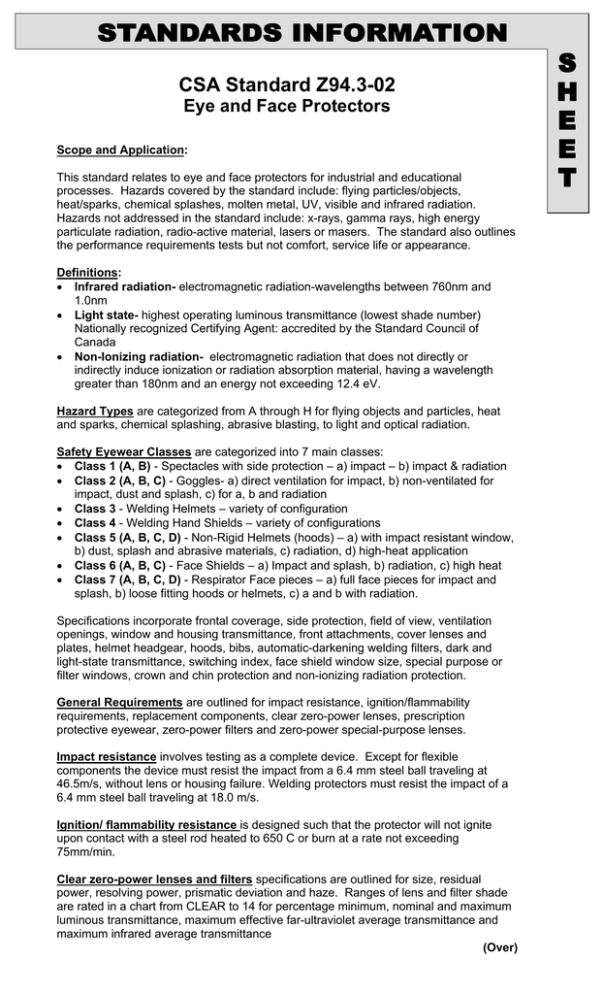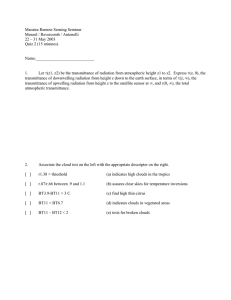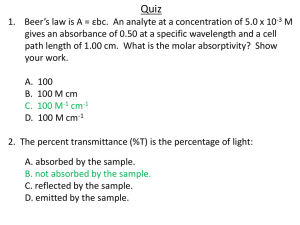CSA Standard Z94.3-02
advertisement

CSA Standard Z94.3-02 Eye and Face Protectors Scope and Application: This standard relates to eye and face protectors for industrial and educational processes. Hazards covered by the standard include: flying particles/objects, heat/sparks, chemical splashes, molten metal, UV, visible and infrared radiation. Hazards not addressed in the standard include: x-rays, gamma rays, high energy particulate radiation, radio-active material, lasers or masers. The standard also outlines the performance requirements tests but not comfort, service life or appearance. Definitions: • Infrared radiation- electromagnetic radiation-wavelengths between 760nm and 1.0nm • Light state- highest operating luminous transmittance (lowest shade number) Nationally recognized Certifying Agent: accredited by the Standard Council of Canada • Non-Ionizing radiation- electromagnetic radiation that does not directly or indirectly induce ionization or radiation absorption material, having a wavelength greater than 180nm and an energy not exceeding 12.4 eV. Hazard Types are categorized from A through H for flying objects and particles, heat and sparks, chemical splashing, abrasive blasting, to light and optical radiation. Safety Eyewear Classes are categorized into 7 main classes: • Class 1 (A, B) - Spectacles with side protection – a) impact – b) impact & radiation • Class 2 (A, B, C) - Goggles- a) direct ventilation for impact, b) non-ventilated for impact, dust and splash, c) for a, b and radiation • Class 3 - Welding Helmets – variety of configuration • Class 4 - Welding Hand Shields – variety of configurations • Class 5 (A, B, C, D) - Non-Rigid Helmets (hoods) – a) with impact resistant window, b) dust, splash and abrasive materials, c) radiation, d) high-heat application • Class 6 (A, B, C) - Face Shields – a) Impact and splash, b) radiation, c) high heat • Class 7 (A, B, C, D) - Respirator Face pieces – a) full face pieces for impact and splash, b) loose fitting hoods or helmets, c) a and b with radiation. Specifications incorporate frontal coverage, side protection, field of view, ventilation openings, window and housing transmittance, front attachments, cover lenses and plates, helmet headgear, hoods, bibs, automatic-darkening welding filters, dark and light-state transmittance, switching index, face shield window size, special purpose or filter windows, crown and chin protection and non-ionizing radiation protection. General Requirements are outlined for impact resistance, ignition/flammability requirements, replacement components, clear zero-power lenses, prescription protective eyewear, zero-power filters and zero-power special-purpose lenses. Impact resistance involves testing as a complete device. Except for flexible components the device must resist the impact from a 6.4 mm steel ball traveling at 46.5m/s, without lens or housing failure. Welding protectors must resist the impact of a 6.4 mm steel ball traveling at 18.0 m/s. Ignition/ flammability resistance is designed such that the protector will not ignite upon contact with a steel rod heated to 650 C or burn at a rate not exceeding 75mm/min. Clear zero-power lenses and filters specifications are outlined for size, residual power, resolving power, prismatic deviation and haze. Ranges of lens and filter shade are rated in a chart from CLEAR to 14 for percentage minimum, nominal and maximum luminous transmittance, maximum effective far-ultraviolet average transmittance and maximum infrared average transmittance (Over) (cont’d) Test Methods are described for impact tests for class, type, lens material, ignition and flammability, residual and resolving power, prismatic deviation, haze, regular luminous transmittance and total luminous transmittance. Luminous transmittance is determined with Standard Illuminant A described in CIE (International Commission on Illumination) and by test method ASTM D 1003. Methods are outlined for testing filter permanence after heat, moisture and ultraviolet radiation exposure, dioptric power, particle penetration of ventilation openings, field of view, suspension function and the switching index. Markings must be present on the lenses, spectacle fronts and sides, removable side shields, goggle eye cup and frame, helmet housings and headgear, hand shield and face shield headgear. Zero power lenses and filters are to be marked with shade number. Special purpose lenses shall be identified as “not for use” where filter lenses are required. Replacement parts shall bear markings or certification is void. User Information to include assembly, fitting, cleaning and storage instructions, inspections criteria, end of life determining factors, maintenance instructions, hazard applications and protector limitations. Transmittance Requirements calculations methods are provided for general purpose filters for protection from ultraviolet, visible and ultraviolet light. Diagrams are included for eye and face protectors and test equipment. Charts are included for ease of determining the switching time (ms), sphere and cylinder power and axis of cylinder for prescription lenses, selection of appropriate eye wear, spectral weighting factors and shade selection. This bulletin contains a summary of excerpts taken from the Standard, for general information purposes only. This bulletin is not reflective of the complete requirements that the Standard prescribes. Note: Manitoba Regulation M.R. 217/2006 Section 1.4 inconsistency: If there is an inconsistency between this regulation and a requirement contained in a publication, code or standard referenced in this regulation, the provisions in this regulation prevail.

